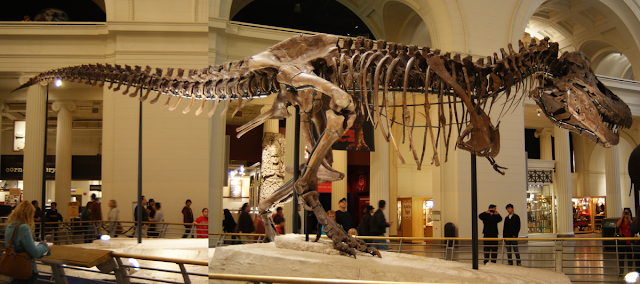Recently I've been thinking especially hard about ways in which the pedagogical tools I like to use can be applied to a variety of disciplines and topics. This is especially the case with having students take on roles or viewpoints, which can serve goals of building empathy or encouraging the practice of disciplinary skills for almost any learning. Today, I want to share an example of something I did last week in my HIST 103 (A History of Everything: The Big Bang to Big Data) sections. Much of the work we've done recently has been on topics commonly considered more scientific than humanistic (particularly being that we are still predating human history at this point in the course). However, part of my and Professor David Sepkoski's goals for the course are to bring these perspectives closer together, examining the ways in which scientific inquiry can inform a long look at the past and how social and cultural forces inform the ways we understand and practice science.
 |
| The skeleton of Sue the T. Rex, currently at the Field Museum. Photo from Peoria Public Radio/Dallas Krentzel. |
For last week, we read a chapter of David Christian's Maps of Time and an article from the New Yorker magazine, The Day the Dinosaurs Died. We had several other things to do in class that day-- some questions from lecture, some recent changes to the course schedule-- so we didn't have a great deal of time to do anything fancy. On the surface, my plan for the day was a simple debate.
But how to frame a debate about dinosaurs? Representing the viewpoint of the asteroid seemed potentially amusing but not particularly useful. Fortunately, the New Yorker article is a gem of a source. In explaining a massive paleontological find relating to the asteroid which wiped out the dinosaurs in the late Cretaceous period, it also provides ample evidence of the social and political limitations to the practice of paleontology and suggests several reasons one could doubt the findings of Robert DePalma, protagonist of the article and grad student in paleontology at the University of Kansas. Framing a debate around these details offered the chance to explore some of the ways that scientific practice is necessarily mediated by humanistic considerations-- that is, by humanity.
My sections have 25 people each, which can get a bit unwieldy. I first asked them to skim through the article quickly to find a few pieces of evidence for DePalma and his interpretation of the evidence or against it. I then split them into groups:
1 and 3: Pro-DePalma--- they believe his findings and think he's made a critical discovery.
2 and 4: Anti-DePalma-- they are skeptical of him and his findings.
Each group planned their statement for three minutes, then had one minute to speak, using the evidence they had mined in their individual reading and refined in their group discussions.
These four groups made up about 3/4 of the class; the fifth group was a group of impartial judges. I used Reacting to the Past as an inspiration to add that critical game-changing element-- a group of indeterminates with no stakes in the debate. These students asked questions of the pro- and anti- DePalma groups and ultimately voted on whether or not DePalma was credible. Intriguingly, each of my three sections came to different conclusions on DePalma's credibility, though they all mentioned most of the same evidence.
Of course, if you're using this article or addressing this topic, you could take this activity and do it just the same-- handy! But using this article to frame a brief class debate also illuminated for me how useful it would be to do the same with many other sources. In academia, there are frequently multiple viewpoints at play regardless of the discipline-- different explanations of how evolution has unfolded, contrasting critical theories for explaining nearly everything, etcetera. Sometimes, we can even find evidence of how things outside of the research itself-- access to sources or data, institutional affiliation, class, race, gender, disability, citizenship, etcetera-- impact the way the work gets done, or determine whether it gets done at all. To open these topics to our students is to invite them to not just practice our disciplines but to consider the limitations of our disciplines.
Related Links:
Good ol' Wikipedia is probably the most up-to-date info on the ongoing investigation of Tanis, DePalma's dig site.
An interesting game: Comparing the various search results about Sue the T. Rex. There's the subject of another potential dinosaur debate for your classroom!
No comments:
Post a Comment